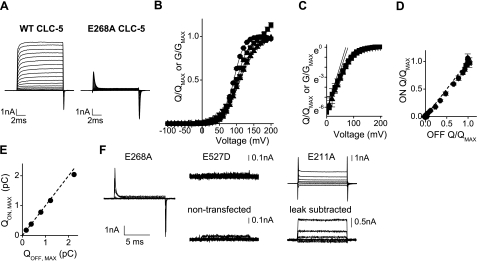Figure 1.
Voltage-dependent charge-displacement observed with a transport-deficient CLC-5 mutant. A) Representative whole-cell current families recorded from HEK cells transiently transfected with wild-type (WT) and E268A CLC-5. Cells were held at −30 mV, and 10-ms pulses were applied to voltages between −100 and +200 mV at 10-mV intervals. B) Relationship between the charge displaced and voltage for the transient currents at the onset of (QON, ■) and immediately after (QOFF, ●) the voltage pulse. Data are expressed as means ± se of ≥5 different cells. QON currents fail to plateau due to the activation of an endogenous conductance with large depolarization, which was subsequently subtracted as described in the main text. Also shown is the WT CLC-5 conductance-voltage relationship (▴) and the charge displaced during the WT CLC-5 tail current (▾). Fitted curves are all Boltzmann functions. C) Same data for WT CLC-5 conductance (▴) and E268A CLC-5 QON (■) on a semilogarithmic plot to measure the limiting logarithmic slope, zgF/RT, fitted to the steepest part of the plot, indicated by the solid lines. D) Relative E268A QON and QOFF data from the graph in B plotted against each other to show the correlation in each pulse to different potentials. Dotted line is QON = QOFF. E) Correlation between the maximum QON and QOFF measured from 5 different cells expressing E268A CLC-5. Data points are individual cells; dotted line is QON = QOFF. F) Current sweeps from voltage pulses to −100 to +200 mV in 50-mV intervals from a cell expressing E268A, E527D, a nontransfected cell, and E211A before (E211A), and after leak subtraction (leak subtracted).

